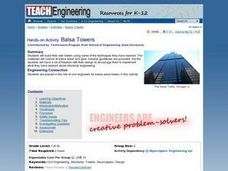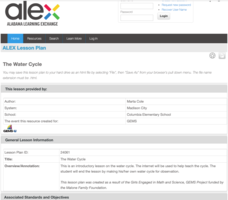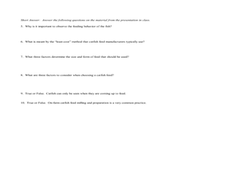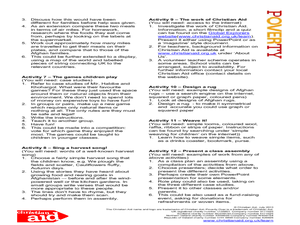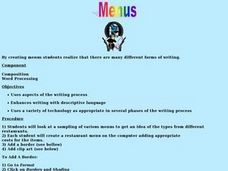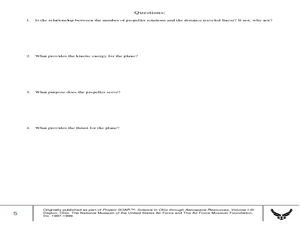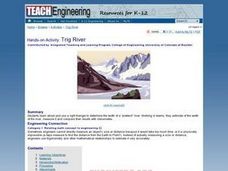Curated OER
Attributes of Accuracy
Students explain necessity in using accurate instruments when measuring, and how measurements can be checked for accuracy. They make a six-inch ruler, design, test, and evaluate a system to measure work, and produce a table and graph to...
Curated OER
Design Team Challenge
Pupils work in groups to build a robot. For this robotics lesson, students create an electronic robot and program it to follow directions. They create an obstacle course for the robot to follow and test its performance.
Curated OER
Science is a Wonderland
Students use the scientific method to study Animalia and Plantae Kingdoms. In this science inquiry activity, students watch a PowerPoint about science process skills. Students complete the National Geographic bottled Eggs-periment or the...
Curated OER
Aerospace
Learners experiment with weight and balance of a glider. In this flight activity students construct their own flying glider and record their experiment with it.
Curated OER
Balsa Towers
Middle schoolers build their own tower using concepts from previous lessons. They are given a set of materials to use and general guidelines. They share what they have created with their classmates.
Curated OER
Beyond the Earth Part II
Students explore the solar system. In this solar system lesson plan, students use Internet and print resources to research a component of the solar system. Students create travel brochures based on their research findings.
Alabama Learning Exchange
The Water Cycle
Students explore the water cycle. In this earth science lesson plan, they read the book Water Dance by Thomas Locker and use an interactive whiteboard to review the water cycle with an interactive website.
Curated OER
From Lake to Tap
Learners use the Internet to study how water is treated to make it safe to drink. They use a tutorial on the U.S. Environmental Protection Agency's website to gain this information. They complete a worksheet for the assessment portion...
Curated OER
Those Cells Look Good Enough to Eat
Students explore the parts of the cell. In this cell lesson, students use foods to create cell models that represent the nucleus, cytoplasm, cell membrane, mitochondria, ribosomes, vacuoles, endoplasmic reticulum, and Golgi bodies...
Curated OER
A Penny For Your Thoughts: Cross-Curricular Journal Writing
Students are introduced to the importance of journal writing. After creating their own journal, they write their thoughts and feelings about different subjects. If they choose to they can share their writings with the class to end the...
Curated OER
A Day at the Beach-Why Did We Do It?
Students investigate pollution at the beach. In this environmental lesson, students participate in a beach clean-up and calculate the weight of the debris collected. Students write a reflection in their journal about their beach clean-up...
Curated OER
Lift and Drag: Principles of Flight and the Soaring Imagination
Learners construct models of early gas balloons and gliders. In this balloon and glider instructional activity, students create models of early gas balloons and gliders, discover how the forces of lift and drag effect aircraft in...
Curated OER
Playing Historical Detective: Great Grandmother's Dress and Other Clues to the Life and Times of Annie Steel
Students draw conclusions about an mystery person based on documents and artifacts provided. In this drawing conclusions activity, students become detectives by reading and analyzing evidence provided. This activity includes...
Curated OER
Aquaculture Science
Students research the different careers in aquaculture. In this aquaculture lesson students complete activities that include a PowerPoint presentation.
Curated OER
Harvest
Pupils research the harvest period in Afghanistan. In this harvest lesson plan, students learn about Afghanistan's weather, games children play, rug designing, harvest songs, and more about the harvest time.
Curated OER
Crystals: What Are They and What Holds Them Together
Students are introduced to the characteristics of crystals and what keeps them together. Using the Periodic Table, they examine the various elements and develop a model of an atom. In groups, they place sugar and salt in petri dishes...
Curated OER
Menus
Students explore different styles of writing. In this writing lesson, students look at menus to get an idea of how many different types of writing there are. Students create their own menus and add border and clip art.
Curated OER
Propellers, Forces and Energy
Students construct a model airplane, measure distance, and calculate velocity. For this creative lesson students work in groups to build a model and use it to calculate distances and velocity.
Curated OER
War on Waste
Students take a closer look at food waste. In this global studies lesson, students perform a waste audit at their school and institute a lunchbox challenge to reduce food waste. Students may also complete the extension activities.
Curated OER
Secrets and Spies
Students explore the lives of spies. In this secret government agencies lesson, students visit the Imperial War Museum and the Essex Secret Bunker online or in person to discover details about Britain's spies and secret bunker.
Curated OER
Coastal Threat: A Story in Unit Conversions
Students convert measurements from one unit to another. In this math lesson plan, students study the environmental consequences of oil spills. They replicate an oil spill event by modeling and scaling.
Curated OER
Making Clouds: Aerosol-Cloud Interactions in a Beaker
Students observe a teacher demo on how clouds form. In this earth science lesson, students discover how cloudiness affects relative humidity. They explain the scattering of light by clouds.
Curated OER
Newspaper Tower
Students design and construct a tower out of newspaper using a limited supply of newspaper, tape, and scissors. After completing their designs, they identify which designs can withstand the self-weight of the newspaper tower as well as...
Curated OER
Trig River
Students calcute distances using trigonometry and angle measurements. They estimate the width of the Trig River, measure it and compare their results with their classmates. They collaborate with a group to research and find the results.




